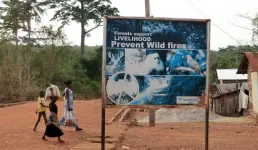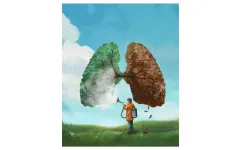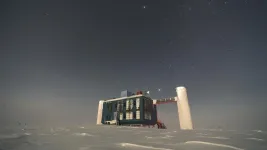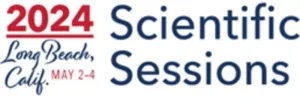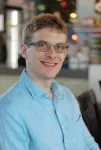(Press-News.org) The use of femtosecond lasers to form glass-to-glass welds for solar modules would make the panels easier to recycle, according to a proof-of-concept study conducted by researchers at the U.S. Department of Energy’s National Renewable Energy Laboratory (NREL).
The welds would eliminate the need for plastic polymer sheets that are now laminated into solar modules but make recycling more difficult. At the end of their useful lifespan, the modules made with the laser welds can be shattered. The glass and metal wires running through the solar cells can be easily recycled and the silicon can be reused.
“Most recyclers will confirm that the polymers are the main issue in terms of inhibiting the process of recycling,” said David Young, senior scientist and group manager for the High-Efficiency Crystalline Photovoltaics group in the Chemistry and Nanoscience department at NREL. Young is lead author of a new paper outlining the use of laser welds for solar modules. The paper, “Towards Polymer-Free, Femto-Second Laser-Welded Glass/Glass Solar Modules,” appears in the IEEE Journal of Photovoltaics.
Written with NREL colleagues Tim Silverman, Nicholas Irvin, and Nick Bosco, the paper also counts as its coauthors two employees of Trumpf Inc., the California company that made the femtosecond laser involved. A femtosecond laser uses a short pulse of infrared light that melts the glass together to form a strong, hermetic seal.
The glass weld can be used on any type of solar technology—silicon, perovskites, cadmium telluride—because the heat of the weld is confined to a few millimeters from the laser focus.
Solar modules are made of semiconductors designed to capture a specific portion of the solar spectrum, harnessing sunlight to create electricity. Typically, the semiconductors are sandwiched between two sheets of glass laminated together with polymer sheets.
NREL’s research showed that femtosecond laser, glass/glass welds are essentially as strong as the glass itself.
“As long as the glass doesn’t break, the weld is not going to break,” he said. “However, not having the polymers between the sheets of glass requires welded modules to be much stiffer. Our paper showed that with proper mounting and a modification to the embossed features of the rolled glass, a welded module can be made stiff enough to pass static load testing.”
NREL’s research is the first to use a femtosecond laser to form glass/glass welds for use in a module. A different type of edge sealing using nanosecond lasers and a glass frit filler was tried in the past, but the welds proved too brittle for use in outdoor module designs. The femtosecond laser welds offer superior strength with hermetic sealing at a compelling cost.
Young said the research is “definitely high risk, high reward,” but points to a direction for further research to extend the life of solar modules to beyond 50 years and to allow easier recycling.
This research was done through the Durable Module Materials Consortium, which is led by NREL and funded through the U.S. Department of Energy's Solar Energy Technologies Office in the Office of Energy Efficiency and Renewable Energy
NREL is the U.S. Department of Energy's primary national laboratory for renewable energy and energy efficiency research and development. NREL is operated for DOE by the Alliance for Sustainable Energy LLC.
END
NREL proof of concept shows path to easier recycling of solar modules
Use of lasers to melt edges of glass together eliminates troublesome polymers
2024-05-02
ELSE PRESS RELEASES FROM THIS DATE:
NREL invites robots to help make wind turbine blades
2024-05-02
Researchers at the U.S. Department of Energy’s National Renewable Energy Laboratory (NREL) have successfully leveraged robotic assistance in the manufacture of wind turbine blades, allowing for the elimination of difficult working conditions for humans and the potential to improve the consistency of the product.
Although robots have been used by the wind energy industry to paint and polish blades, automation has not been widely adopted. Research at the laboratory demonstrates the ability of a robot to trim, grind, and sand blades. Those necessary steps occur after the two sides of the blade are made using a mold ...
Scent sells – but the right picture titillates both eyes and nose, research finds
2024-05-02
Scented products with relevant images on their packaging and branding, such as flowers or fruit, are more attractive to potential customers and score better in produce evaluations, new research confirms.
And such images, the researchers conclude, are particularly effective if manufacturers and marketers choose pictures that are more likely to stimulate a stronger sense of the imagined smell – for example, cut rather than whole lemons. This, they say, suggests that as well as seducing our eyes, the images are stimulating our sense of smell.
The study, published online in the International Journal of Research in Marketing, could provide manufacturers and marketers ...
Low intensity light to fight the effects of chronic stress
2024-05-02
Some neurological disorders can be improved through photobiomodulation, a non-invasive technique based on the application of low-intensity light to stimulate altered functions in specific regions of the body. Now, a study published in the Journal of Affective Disorders reveals how photobiomodulation applied to the brain-gut axis is effective in recovering some cognitive alterations and sequelae caused by chronic stress. The study opens up new perspectives for applying the technique in future therapies for the treatment of neurological diseases in patients.
The article, based on the study of laboratory animal models, ...
Wildfires in wet African forests have doubled in recent decades
2024-05-02
American Geophysical Union
Press Release 24-19
2 May 2024
For Immediate Release
This press release is available online at: https://news.agu.org/press-release/africa-forest-fires-doubled-drying
Wildfires in wet African forests have doubled in recent decades
Climate change and human activities like deforestation are causing more fires in central and west Africa’s wet, tropical forests, according to the first-ever comprehensive survey there. The fires have long been overlooked.
AGU press contact:
Rebecca Dzombak, news@agu.org (UTC-4 hours)
Contact information ...
Dietary changes may treat pulmonary hypertension
2024-05-02
Blood vessels in the lungs aren’t like the others in the body. This difference becomes clear in pulmonary hypertension, in which only the lungs’ blood vessels stiffen progressively, leading to chronic lung disease, heart failure and death. The underlying reasons for this organ-specific vessel stiffening remained a mystery until University of Pittsburgh researcher Stephen Chan and colleagues made a surprising discovery about these blood vessel cells in patients with pulmonary hypertension—they’re hungry.
Chan, Vitalant Chair in Vascular Medicine and Professor of Medicine in the Division ...
UTA scientists test for quantum nature of gravity
2024-05-02
Einstein’s theory of general relativity explains that gravity is caused by a curvature of the directions of space and time. The most familiar manifestation of this is the Earth’s gravity, which keeps us on the ground and explains why balls fall to the floor and individuals have weight when stepping on a scale.
In the field of high-energy physics, on the other hand, scientists study tiny invisible objects that obey the laws of quantum mechanics—characterized by random fluctuations that create ...
SCAI announces recipients of 2024 early career research grants
2024-05-02
Today, the Society for Cardiovascular Angiography & Interventions (SCAI) announced the recipients of the 3rd Annual SCAI Early Career Research Grants. SCAI offers this initiative to support the next generation of interventional cardiologists, providing a platform for junior-level investigators within 10 years of completing an interventional cardiology fellowship to study high-priority, clinically important topics and have their findings disseminated through various professional channels. This year’s grants are funded by support from Edwards Lifesciences, Medtronic, and Shockwave Medical.
“Research funding is often ...
AI can tell if a patient battling cancer needs mental health support
2024-05-02
Researchers at UBC and BC Cancer have developed a new artificial intelligence (AI) model that can accurately predict if a person receiving cancer care will require mental health services during their treatment journey.
The AI uses natural language processing and advanced neural networks to analyze an oncologist’s notes from their first consultation appointment with a patient. While these appointments are typically highly focused on a patient’s medical history and treatment options, the AI picks ...
ISSCR announces Hong Kong, SAR as location for its 2025 Annual Meeting
2024-05-02
The world’s leading stem cell scientists will convene in Hong Kong, SAR, 11-14 June 2025 for the International Society for Stem Cell Research (ISSCR) 2025 Annual Meeting, illuminating the future of stem cell science and highlighting the most compelling research and clinical advances of the year. The meeting is co-sponsored by The University of Hong Kong, The Chinese University of Hong Kong, and Hong Kong University of Science and Technology. The Hong Kong Innovation and Technology Commission and the Hong Kong Convention and Exhibition Centre provided significant support to enable the ISSCR to bring its hallmark event to the city of ...
Zoology: First report of wound treatment by a wild animal using a medicinal plant
2024-05-02
A wild male Sumatran orangutan (Pongo abelii) has been observed applying chewed leaves from Akar Kuning (Fibraurea tinctoria) — a climbing plant used in traditional medicine to treat wounds and conditions such as dysentery, diabetes, and malaria — to a wound on his cheek. The findings, which are published in Scientific Reports, represent the first report of suspected wound treatment by a wild animal using a plant with known medicinal properties.
Prior to this study, multiple ...
LAST 30 PRESS RELEASES:
Ticking time bomb: Some farmers report as many as 70 tick encounters over a 6-month period
Turning garden and crop waste into plastics
Scientists discover ‘platypus galaxies’ in the early universe
Seeing thyroid cancer in a new light: when AI meets label-free imaging in the operating room
Neutrophil-to-lymphocyte ratio may aid risk stratification in depressive disorder
2026 Seismological Society of America Annual Meeting
AI-powered ECG analysis offers promising path for early detection of chronic obstructive pulmonary disease, says Mount Sinai researchers
GIMM uncovers flaws in lab-grown heart cells and paves the way for improved treatments
Cracking the evolutionary code of sleep
Medications could help the aging brain cope with surgery, memory impairment
Back pain linked to worse sleep years later in men over 65, according to study
CDC urges ‘shared decision-making’ on some childhood vaccines; many unclear about what that means
New research finds that an ‘equal treatment’ approach to economic opportunity advertising can backfire
Researchers create shape-shifting, self-navigating microparticles
Science army mobilizes to map US soil microbiome
Researchers develop new tools to turn grain crops into biosensors
Do supervised consumption sites bring increased crime? Study suggests that’s a myth
New mass spec innovation could transform research
Maternal nativity, race, and ethnicity and infant mortality in the US
Migration-related trauma among asylum seekers exposed to the migrant protection protocols
Jupiter’s moon Europa has a seafloor that may be quiet and lifeless
SwRI upgrades nuclear magnetic resonance laboratory for pharmaceutical R&D
House sparrows in northern Norway can help us save other endangered animals
Crohn's & Colitis Foundation survey reveals more than 1/3 of young adults with IBD face step therapy insurance barriers
Tethered UAV autonomous knotting on environmental structures for transport
Decentralized social media platforms unlock authentic consumer feedback
American Pediatric Society announces Vanderbilt University School of Medicine as host institution for APS Howland Visiting Professor Program
Scientists discover first method to safely back up quantum information
A role for orange pigments in birds and human redheads
Pathways to net-zero greenhouse gas emissions for Southeast Asia
[Press-News.org] NREL proof of concept shows path to easier recycling of solar modulesUse of lasers to melt edges of glass together eliminates troublesome polymers

